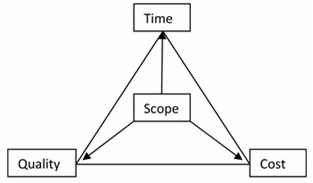Traditional project management has been practiced and enriched over decades in different domains such as construction, defense, technology… etc. Most of the literature like PMI and PRINCE try to formalize this discipline and focus on giving it clear steps that you follow from start to the end of the project.
Scope is in the heart of traditional project management

Being PMP certified and an early adopter of Agile and Lean principles, I felt like flipped on my head when I moved from traditional project management to Agile. In project management, there is a lot of emphasis on defining the scope upfront and there are many tools and techniques that guide this process. The goal is to nail down the scope and to remove any ambiguity to prevent scope creep down the road so that time, quality and cost are not impacted. And while the project is executed, traditional project management focuses mainly on the time and cost, and a bit less on the quality.
Agile, on the contrary, was created to allow scope ambiguity and to replace the fear of scope creep by the culture of experimentation and feedback from the customer and stakeholders, which adapts and drives the way we progress.
This means working with teams differently and allowing them to inspect, learn and be more flexible as opposed to have a clear path from start to end.
Agile teams usually have many different skills that allow them to come up with ideas and suggestions for changes and deviations along the way. However, project managers are not always ready for that and they are not expecting that kind of input anyway. All what they like hearing is “I’ve completed my task what’s next?”
Traditional project managers tend to distance themselves and start with a detailed project plan, full specs and requirements. Then take a step back and work in isolation to come back after a long period of time to close the project.
I think this is something you need to watch out for, to open up, to be close to the client and team, and to allow for full transparency throughout the project.
From resource management perspective, traditional techniques have been developed on the idea that we may have a resource join our project but then go off and work on a completely different project because they have a unique skill set that they only can complete certain type of tasks that move down the chain.
In Agile, project team forms a single unit of self-organizing and multidisciplinary members that move together and have capabilities to move from one task to another, help each other out and finish the work in iterations.
Finally, I believe that software project managers should shift their thinking of project as a unique set of activities with start and end, and move towards thinking of it as a process of product management. The term “project management” as defined in traditional literature doesn’t apply to software and should be called “product management”, which is about constant continuous delivery that is done in small iterations.